Two years after a midday meal took the lives of 23 children in Gandaman, Archana Masih sits down to have lunch at the same government school and discovers that much has changed and much remains the same.
Rediff.com looks at Bihar through the lives of its people.
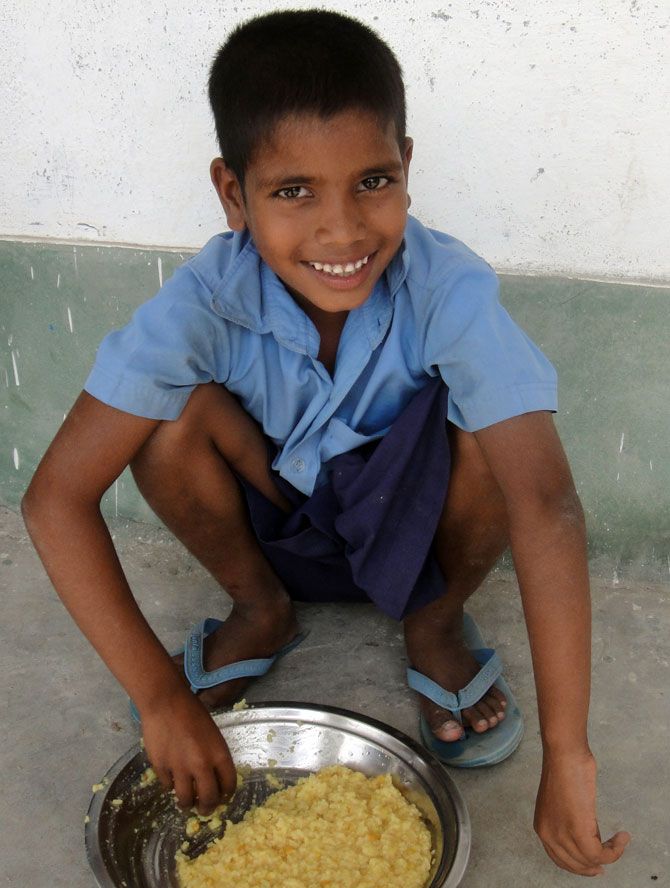
A few yards away from where Gandaman's tragic past lies buried, school children sit down for their midday meal.
Today it is khichdi and chokha (mashed potatoes). Three cooks had made the meal using 5 kgs of rice, 2 kgs of masoor and chana dal; and 5 kgs of potatoes for the chokha which is flavoured with flakes of red chilli.
They have cooked less than usual because few children have come to school. With Durga Puja holidays around the corner, attendance is thin.
In the kitchen is a hand-made mud chulha. The food is cooked on a wood fire. Two big tin containers store the rations in plastic packets. A heap of potatoes lie in one corner. Six, seven sacks of rice have just been stocked the previous day where Sampati Kawar, one of the cooks, is sitting on the floor and eating the just-cooked meal.
I find it odd that she is eating before the children are fed, but am told that the government rule prescribes that the cook eats first followed by the teacher. Only after that are the children to be served.
If this rule had existed two years ago 23 children from this school would not have died after eating lunch. The school ground became the final resting place for some after their parents cremated them where the children had spent the final hours of their short lives.
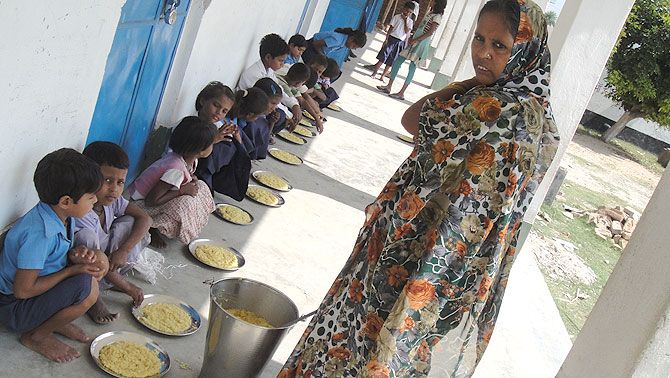
That day the food was laced with pesticide. The children died -- some right here, some on the way to hospital. A long way off from the main road, the tyranny of distance struck an even harder blow.
The tragedy compelled the government to move the two-room primary school into a bigger, newly constructed, building. The floor above is still being built, but the lower one has been functioning -- and it is in its corridor that children sit with their chipli (Bhojpuri for steel plate), waiting to be served.
Rajpati Kawar brings the khichdi in a steel bucket and serves the children. Sampati Kawar follows with mashed potatoes. The two cooks share the same surname because they are widows.
"When you are unmarried you are called 'Kumari,' when you get married you are 'Devi' and when you are widowed you are 'Kawar'," Sampati explains the rather harsh nomenclature.
The cooks are paid Rs 1,000 per month by cheque, but say they hardly ever get paid on time. The money is given to them every few months.
Rajpati complains that in the one year she has been employed she hasn't been paid even once.
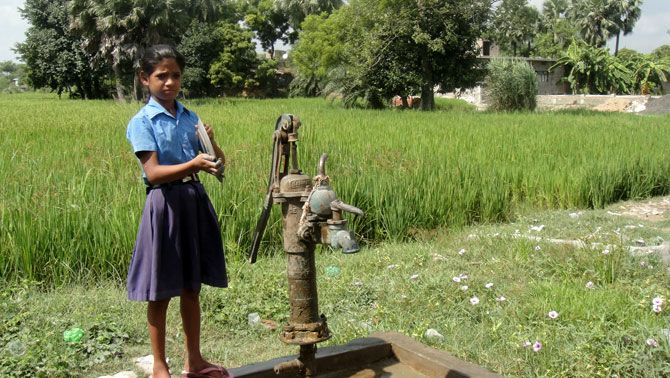
The kitchen is a one room, fairly large space. The daily menu is painted on the wall outside. It is a Wednesday and the mashed potatoes should have been mixed with some green vegetables, but it isn't. A teacher tells me that sometimes greens are difficult to procure from the local market in the rainy season.
There have been tales of mismanagement and corruption in the government's midday meal schemes, not only in Bihar but also in other states. In this school, lunch wasn't served for almost a month recently because there was no supply of fire wood and rice.
Villagers say when the media arrived, the school organised food from outside which led to a brawl with villagers. Three of them have an FIR against them, two of whom I met outside the school.
This is my third trip to the school since the tragedy and I have walked into the school without prior information, with a chipli of my own, hoping to taste the day's midday meal.
The teachers offer me a plate; and such is our level of confidence in what the government offers, that I am pleasantly surprised that the meal tastes good.
After finishing their lunch, the children wash their plates at the hand pump, using ash accumulated from the wood fire as soap.
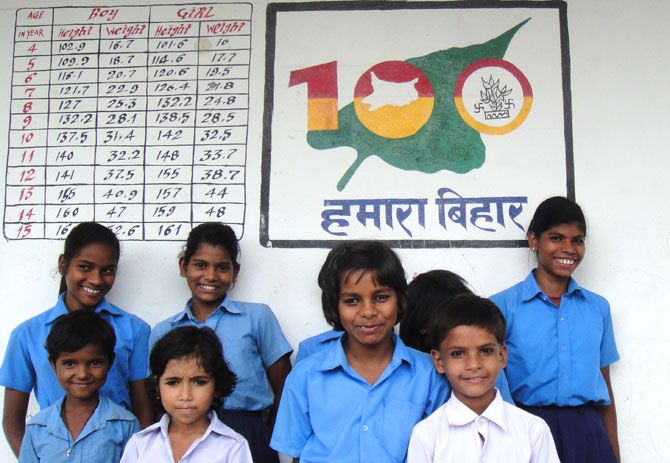
A Hamara Bihar mural brightens the corridor. Most of the classes are locked. The children sit on the floor on plastic gunny bags in the rooms that are unlocked. Plastic jholaS contain their books.
Text books are provided by the government, while exercise books have to be bought by the students.
Some students are in uniform, others are not. The government provides poshak rashi (uniform allowance) once a year. When I ask a girl, why she isn't wearing her uniform, she says it has been washed today.
Not one child is wearing shoes.
Since few children are present today, they have been clubbed together in two classrooms. Three teachers are present. The Class I attendance register has 88 names -- girls outnumber boys in the list.
The building is painted light pink like all government schools; it is newly constructed, but has no electricity or piped water connection.
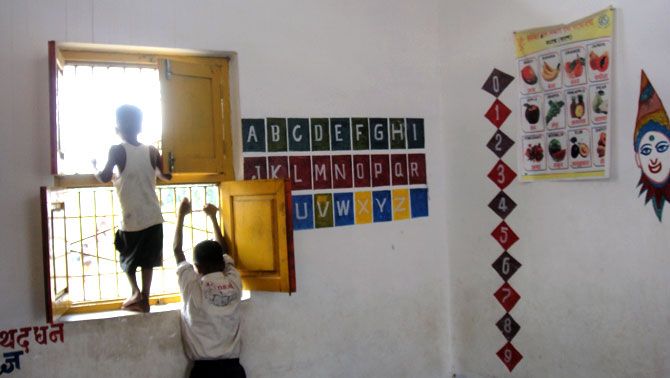
Two hand pumps are outside. Two toilets at the rear overlook a lush green field but have not been cleaned for a long time. Since the doors do not have bolts, they can be used by anyone and have no water connection.
The school girls make a sour face when I ask them if they have ever used it. "Not once," they say, "It is dirty. We go to our homes when we want to go." The school does not have a sweeper on the staff.
I ask the girls if they have toilets at home. They say no. They go into the fields.
The students that I meet are mostly the children of daily wage earners. Amisha, Karishma and Kareena, three sisters who laugh loudly when I ask them about their Bollywood namesakes, say their father does mazdoori in Delhi.
"He will take a train tonight to come home for the holidays," says Amisha, the eldest.
She brings me her notebook which has a picture of Saina Nehwal on the cover. She does not know who she is and I tell her about the badminton champ. The girls remain quiet when asked what they would like to do when they grow up but say they come to school everyday.
I tell them to enroll in the new college that has been just been built opposite when they finish school.
They smile shyly. I am not sure they will -- but I hope they do.
On the way back, I see posters of Saina Nehwal urging people to vote and think of the girl in the village who doesn't know one of India's biggest sporting stars. Of siblings who share the same notebook to save the family's expense. Of schools that are short of competent teachers. There is a view held by many in our country that youngsters should compulsorily spend a year in the army like in Israel. They should advocate volunteering in India's government schools too.
THE I AM BIHAR SERIES










